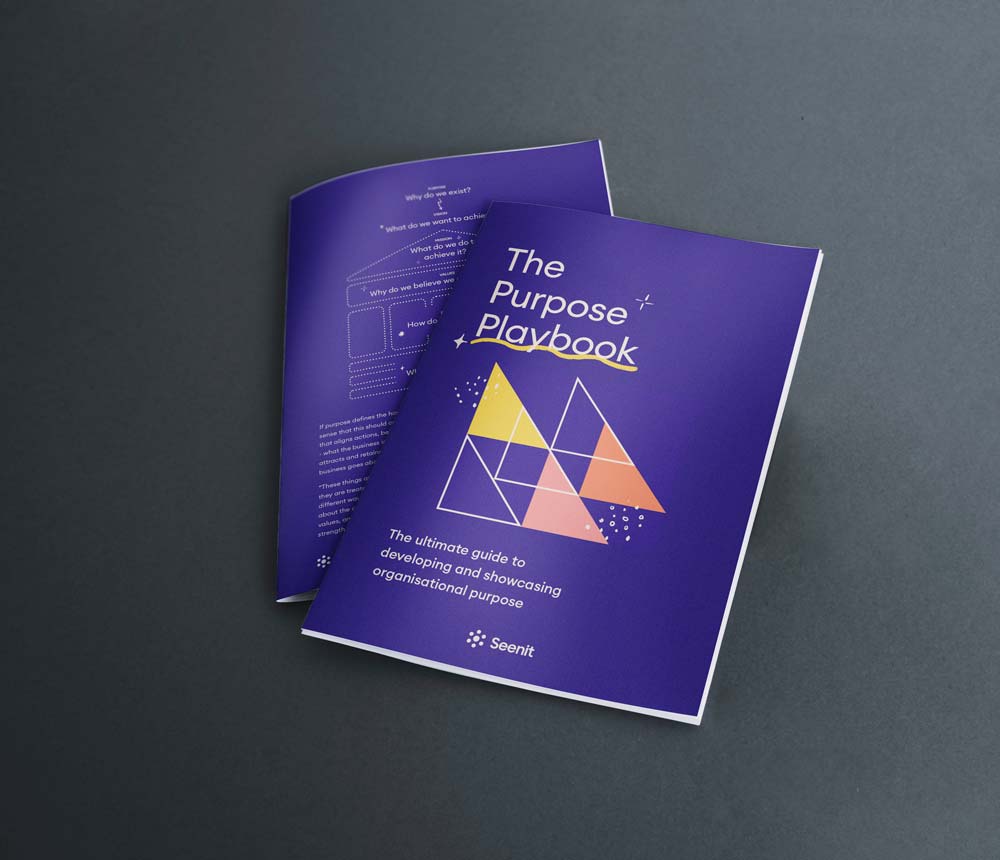1. Intro
The workplace is changing. Employees are demanding more, and for a good reason. In the wake of job uncertainty, the pandemic, and rising living costs, younger generations are increasingly bringing new ideals to the workplace.
In a post-pandemic world, organisations must work purposefully and be guided in their actions by an enshrined principle. Doing so can deliver benefits right across the business. It can improve the decision making of leadership teams, better engage employees, improve productivity and commercial performance, and aid talent recruitment and retention to name but a few.
We truly believe that purpose is key to the survival of business globally. For companies to attract, retain, and engage their people, they must have a clear and lived purpose that sits at the heart of the organisation. This purpose must be weaved through the organisational tapestry, defining your vision, mission, and values. Without a clear purpose, businesses will struggle to keep hold of their people.
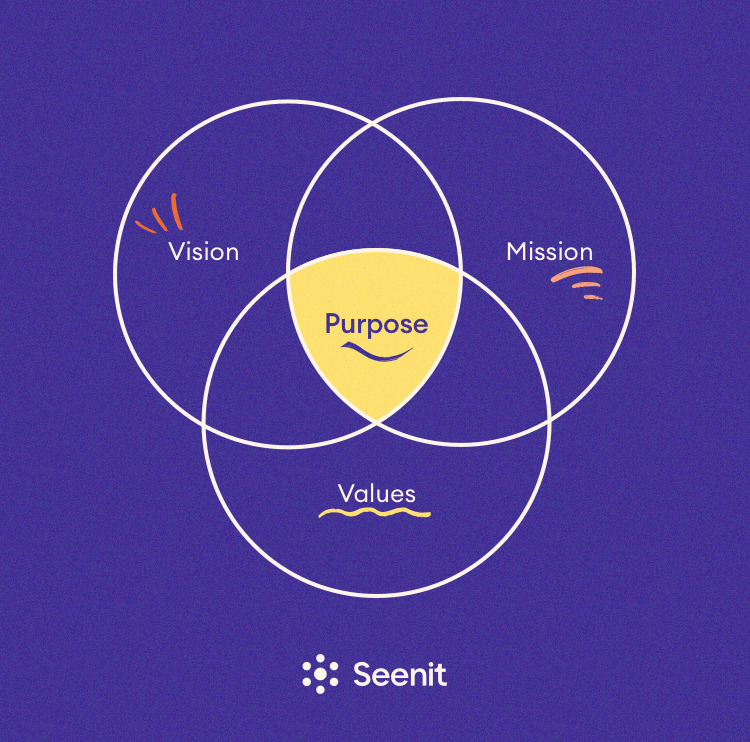
But purpose doesn’t come easy. It’s something that takes time to develop and must be worked at every day to ensure it is a lived truth in the business. This requires persistent vocalisation and socialisation of your purpose – put it on a pedestal and show it off as a living, organic entity through employee video stories and case studies, social post, internal initiatives, and beyond.
Our goal at Seenit is to support and empower the people who look after an organisation’s people. Having a clear sense of purpose is a powerful tool in any arsenal, so in this report, we’ve worked with a number of leading voices in the HR and People worlds to help you better understand what purpose is, why it matters, and how to work on your own North Star. We’ve even sketched out a 6-step plan to support your journey to purpose.
Of course, it’s critical to not just live your purpose but to communicate, share and showcase it to the world - and that’s where Seenit comes in. We’re the ideal partner for showing existing and prospective talent exactly what you stand for in a medium proven to resonate. And that’s how we live our purpose: to create a world where everyone’s story can be told and voice heard. We want to create a more trustworthy world where authentic human stories can be told in impactful ways.
We hope you find this report useful. If you’d like to discuss the topics in more detail or learn how to bring your organisational purpose to life using video, please feel free to reach out to our team.
Emily Forbes, Founder, Seenit
2. What’s the purpose of ‘purpose’?
In an age of rapid change and heightened expectations, having a North Star is vital if you intend to navigate uncertainty successfully.
Purpose is one such organisational North Star. It resonates with employees and leadership alike, guiding decision-making, enabling greater engagement, and pushing commercial performance. But what is the purpose of ‘purpose’, and why does its reach extend so far?
“Organisational purpose sits at the centre of any credible business. It’s why the business was founded and it gives a sense of direction and belief for everything that follows.”
Purpose, then, should be fundamental in any organisational playbook. It defines the why and the how of a business, discerning a reason for being. It provides employees with a guiding principle they can hold themselves against and believe in.
Gone is the 9-5 employee. Today’s Millennial and Gen Z employees want to work for employers that share their values and that invest in the tech and personalisation they’re used to in their everyday lives. Research from workspace platform, Envoy, found that 80% of Gen Z employees believe a company needs to use the latest workplace technology to be successful, while 46% expect personalisation of their experience in the workplace.
And it’s not just employees. Customers, too, are increasingly savvy. Both need to know why companies exist and how they act. If expectations aren’t met they will vote with their feet and wallets. This is why companies cannot overlook purpose.
“Purpose is the absolute, all-encompassing element of organisational design,” says Ben Whitter, Founder and CEO at HEX Organisation and named among HR’s most influential individuals in 2021. “It’s what mobilises an organisation. It’s the same for human beings - we all need to find a purpose.”
The benefits of purpose and why bringing it to life matters
On paper, having an organisational purpose looks like a no-brainer. If you can define the reason your company exists, then everything should fall into place – job done, right? This is a trap too many organisations fall into. Purpose must be tailored to your specific context. If done right, you will reap the rewards.
“The benefits are huge for the organisation and the individual,” “Research has shown that if installed and embedded well into the business model, you will outperform your competitors financially and across every major metric that counts - whether it comes to customer satisfaction, innovation, or profitability.”
Findings from PwC show that almost 4-in-5 business leaders believe that purpose is central to organisational success. Yet, 68% said that purpose isn’t currently used to guide decision-making in their business. Why not? A guiding light enables better decision-making, results, and employee engagement. Further research by the Insurance firm AON Hewitt suggests that firms with engaged employees are 21% more profitable than those with less engaged employees.
“Having a sense of purpose and a set of people that believe in it makes them more engaged,” says Manners. “So then we get all the benefits around engagement such as greater productivity, increased sharing of ideas, and growing advocacy for your business and your brand.”
Purpose can also have a positive effect on both retention and recruitment. Gallup reports that highly engaged workplaces see 41% lower absenteeism, while PwC’s report finds that Millennials with a strong connection to their organisation’s purpose are more than five times more likely to stay at a company. But how do you build this connection? Savvy organisations are increasingly looking towards video content as the answer.
Data from Statista shows that 62% of Gen Z and Millennials watch very short (one minute or less) mobile videos several times a day. In fact, with the rise of platforms like TikTok, many employees are likely to be video content creators themselves. Therefore, using video snippets not only lets you showcase tangible proof of purpose-in-action but enables you to do so in a way that will resonate with existing and prospective employees.
Repeated studies echo the sentiment of employees demanding more from their place of work. A survey by Amazon found that ‘purposeful work’ is now a top-two concern for younger generations, while a study from the People Experience firm, BetterUp, found that more than 90% of employees would trade a percentage of their lifetime earnings for greater meaning at work.
It’s critical then for organisations to not just live their purpose but to show it off to the world.
Our own research suggests that 26% of employees look for videos to see what a company’s culture is like before applying to job roles. Combine this with employee demands for purposeful work and it becomes clear that it is as important to showcase a holistic, purposeful philosophy across the business as it is to instil it in the first place. Making the most of video offers a huge opportunity to showcase purpose and those businesses that embrace this can trigger benefits at every level.
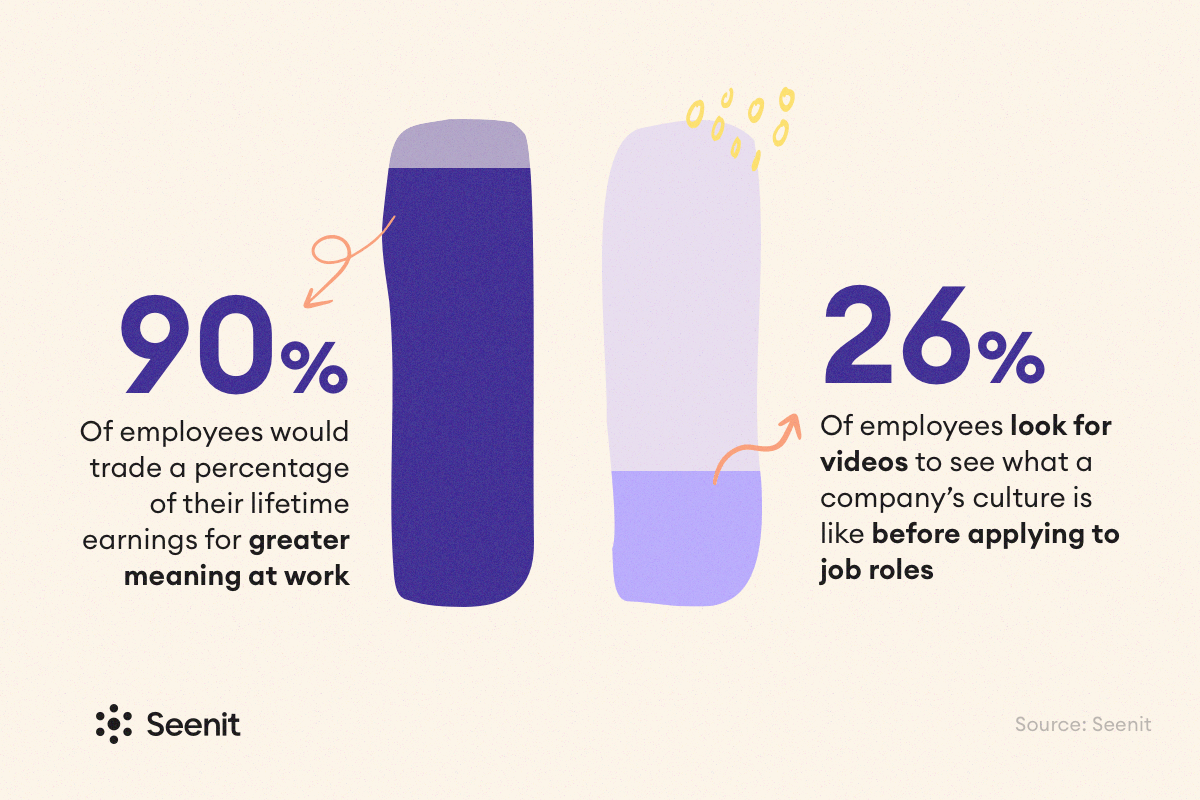
Purpose and responsibility
Purpose also plays a key role at board level, where employee sentiment and thinking is playing an increasingly important role in decision-making around topics of social good.
Purposeful work need not be limited to the organisation. With more employees seeking to make an impact, it’s no surprise that organisations are channelling this into opportunities for social good. Take DocuSign’s ‘DocuSign for Forests’ initiative, in which employees get the day off to plant trees in a local area. It’s an ideal combination of purpose (to eliminate paper from business processes) and societal good (planting trees to replace those already lost).
Similarly, we can look to ViacomCBS’s user-generated ‘Viacommunity Day’ video series, created with Seenit. Employees were encouraged to submit videos from various activities, documenting the different types of remote volunteer programmes that they were able to choose from. Again, it’s the perfect example of empowering purposeful employees to make a positive impact outside of the business.
“Employees from all walks of life wanted to participate, wanted to make a difference in their community and that really shows with the [video] submissions,” says Adam Robinson, VP Corporate Social Responsibility at ViacomCBS. “When we’ve put them all together it was an absolutely beautiful thing to see, clips and highlights from employees all around the world giving back to their communities and doing so in a safe and remote setting.”
Likewise, the rapid rise of the Environmental, Social, and Governance (ESG) agenda is a further example of purpose-driven good coming to the fore. With 85% of US investors interested in sustainable investing according to Morgan Stanely, the benefits of ESG for the business are clear. However, we need to look beyond shareholder interests.
“ESG is about baking the ‘good’ into what you do and how you do it, it’s not a group of separate initiatives, it’s fundamental to the operation. There’s not a perfect answer. Conflicts, trade-offs, investment, and tech are at the core of change - but so is purpose.”
With PwC research suggesting one of the biggest barriers to ESG effectiveness is a lack of attention or support from leadership, it’s clear that organisations need to re-engage with their purpose and purposeful behaviour at the top of a business. Again, video provides an optimal solution for leadership, offering greater transparency, accountability, communicability and content consumability across the business. As Piper notes: change is driven by purpose and tech. Your organisation should look to make the most of both.
Purpose in the business
Given its reach, purpose should also help shape leaders’ thinking around other initiatives such as the organisational mission, vision, Employee Value Proposition (EVP), and broader strategy.
“The combination of purpose, mission, and values needs to become the lived truth of the organisation,” explains Whitter. “Doing so will see the promise on the outside begin to manifest on the inside. Employees will start to believe in it. Managers will start to believe in it. Then, suddenly, we’re not surprised that customers start to believe it too.”
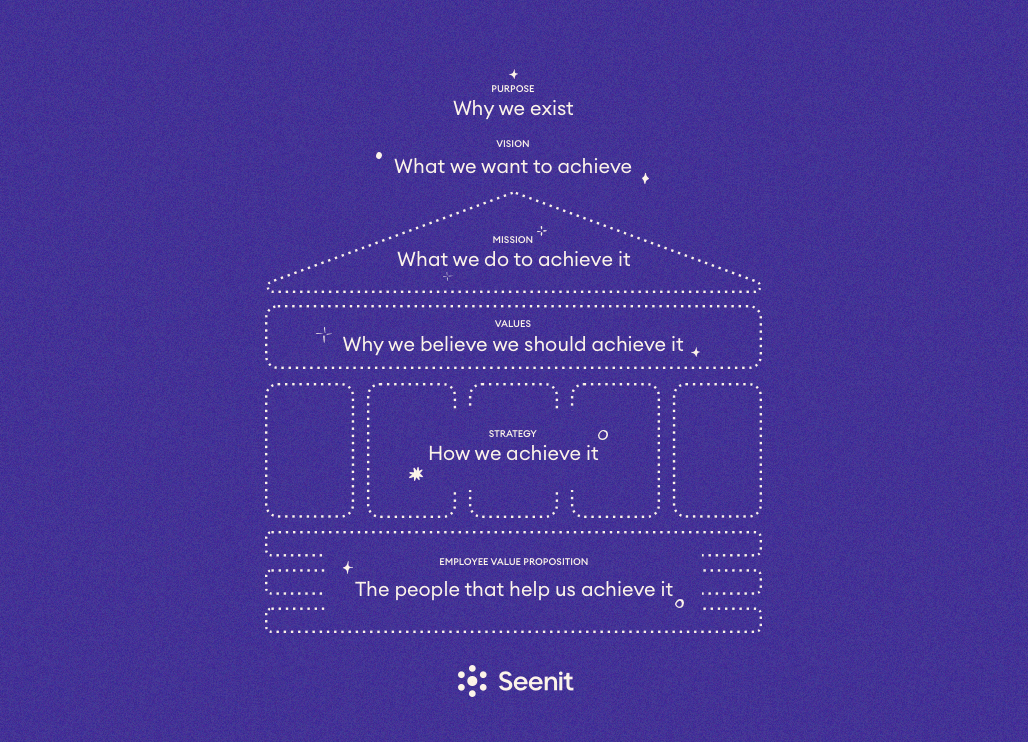
If purpose defines the how and why of a business, then it makes sense that this should colour your mission - the unifying statement that aligns actions, behaviours, and accountabilities; your vision - what the business is striving for; your EVP - how the business attracts and retains employees; and your strategy - how the business goes about achieving its goals and objectives.
“These things are the fuel that creates momentum, but too often they are treated as their own separate entities and dealt with in different ways,” concludes Whitter. “When you really start to think about the connection between purpose, mission, and company values, and you start to harness that as an integrated company strength, that’s when you start to see great performance.”
3. The journey to purpose
For many businesses, ‘purpose’ is a paradox. It’s something that you feel like you ought to invest in but at the same time feels nebulous and undefinable. It’s no surprise then that 86% of B2B businesses recognise purpose as important to growth, according to 2020 research by the Social Purpose Agency, Carol Cone, but only 24% say it is embedded in a way that influences their innovation, operations and broader societal engagement.
The question, then, is how to develop and implement organisational purpose in a way that drives tangible change and impacts? To answer this, we asked three HR and People experts for their thoughts.
How can an organisation develop its purpose?
Matt Manners: Purpose is a journey with no real endpoint. It’s something that organisations should be looking at continually. One of the most important pieces of the puzzle though is having a leader or leadership team that can see this shift, and that wants the business to do better - but to do so by putting people and purpose at the heart of things.
Freddy Cleveley: You need to start at the senior level and establish the how, what, and why for your business: Why do you exist? What do you do? And how do you do it? If they don’t know what your purpose is, then starting this conversation at all levels of the business can help.
Ben Whitter: The superpower with this beyond any question is co-creation. If you work at all levels to harness, develop, and ideate purpose, then it becomes something that is compelling and cherished by everyone. Co-creation could be forums, workshops, design sessions, or something else - but it needs to get people from across the business working together. That’s when you start to get real traction.
What challenges do organisations face when developing their purpose?
MM: One of the biggest challenges is knowing where to start. Because purpose has its own life force, it requires employees to understand it and perpetuate it on a daily basis. Without anything in place, there’s going to be a lot of work to get it on track and build momentum - but it’s an effort that’s worthwhile.
BW: Too many businesses forget to focus on their particular context, company, and people. So a key challenge lies in avoiding the vanilla, the obvious, and the generic. Instead, focus on your specific context and people to develop a good, sustainable purpose.
FC: A major challenge can lie with a lack of good leadership. This kind of change has to come from the top. Those businesses that successfully implement change are those with leaders who can look beyond the short-term. The path to purpose requires leaders to give people permission to fail and to fail fast in order to make a change.
Top 3 challenges inhibiting organisational purpose
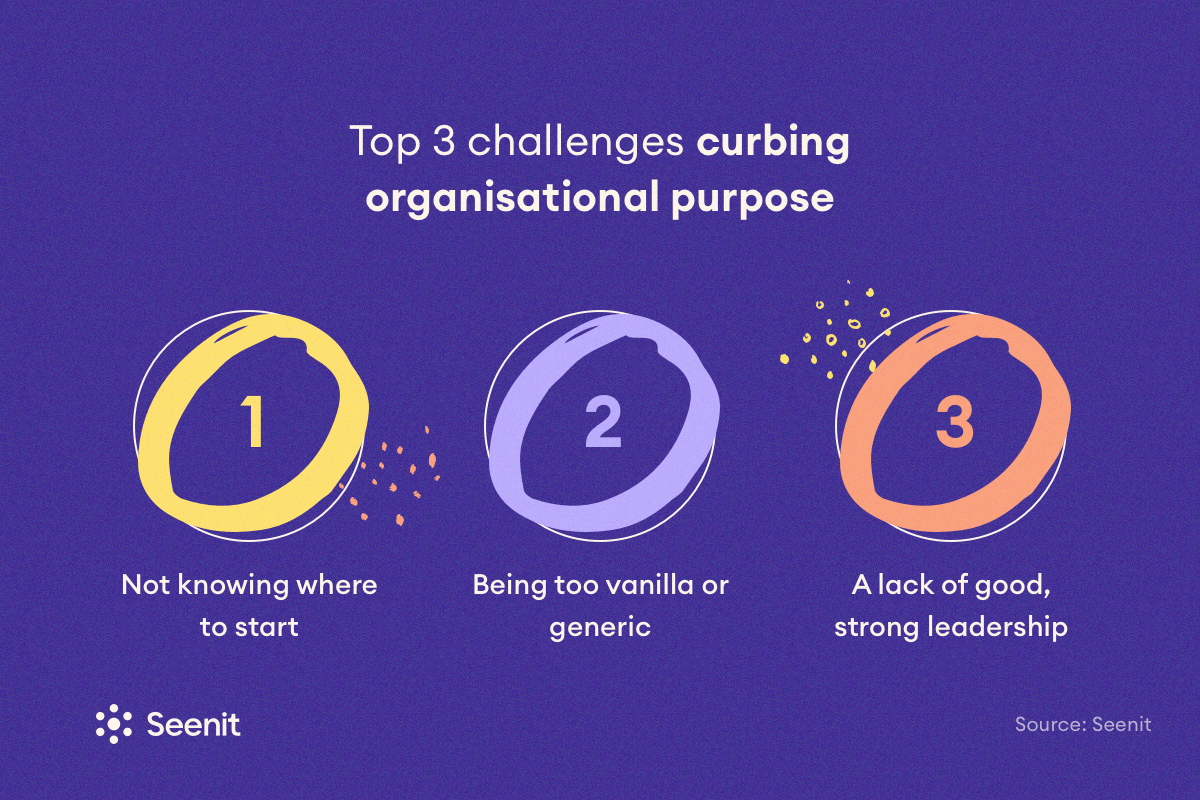
Do organisations of different sizes face different challenges when it comes to developing purpose?
MM: Purpose is something that should come easier for start-ups. If small, young businesses aren’t putting purpose at the heart of their business, they’re missing a trick. But for bigger, older businesses that might have lost their way, success comes down to giving teams a voice. You need to ask for advice in order to define, refine, and instil purpose back into the heart of the business.
BW: I’ve seen businesses at every level try to over-complicate things and it never really joins up in practice. When you’re serious about something from the top-down, regardless of business size, the CEO needs to take a personal responsibility to bring this to life and instil this philosophy throughout the organisation.
Who should be responsible for leading on purpose?
MM: It starts with the C-suite - they need to define the right people to do what needs to be done throughout the organisation. Purpose starts at the top but it’s an organisational-wide piece - you need people who believe in it to help you roll it out.
BW: The CEO and C-Suite should collectively own purpose, but the driving seat should be occupied by customers and employees. These groups are the ones buying the products and accessing the services. They know exactly what your organisation’s purpose should be and that needs to be brought out within the business design and model.
How should an organisation vocalise and establish buy-in for purpose across the business?
BW: That’s a red flag. If you’ve got people talking about “buy in” then they’ve gone completely wrong. You shouldn’t need to buy into something you’ve co-produced with employees because everyone has skin in the game. I think most organisational purposes are aspirational, wishful thinking at best because real purpose is something you have to work at every day.
MM: It comes down to how you foster belonging and trust. We talk about the ‘employee voice’ but this isn’t just about listening to employees. If your people don’t know what your purpose is, you need to start the conversation to realign and find true north again.
FC: You need to relentlessly weave purpose into the fabric of your business and socialise it through the tools in your arsenal: your teams, your tech, and your people. Doing so can build momentum for something that is a real, authentic, and lived experience rather than one that is just talked about.
4. Purpose in action at Amazon (Case study)
So far, we’ve taken a closer look at what organisational purpose is and the positive impacts it can have across an organisation. But what forms can purpose take in the real world and what does it look like in action?
We spoke to Tammy Thieman, Global Director of Amazon Career Choice, about how the organisation’s unique approach to in-house employee education, self-development, and upskilling is a purposeful program.
What is Amazon Career Choice?
Amazon Career Choice is an in-house development program available to hourly employees in 14 countries. It provides education opportunities for individuals to upskill and develop themselves professionally. With a pledge to upskill employees set in stone, Career Choice is part of Amazon’s broader organisational commitment to invest $1.2bn on employee upskilling by 2025.
To provide such development opportunities, Amazon Career Choice partners with local education partners and guidance services to offer the support and coaching employees need based on their self-selected development paths.
“We believe that everybody who comes to Amazon should be able to build their career, whether they stay with us or leave us. We strive to be a good partner in the communities that we live and work. Career Choice provides a real opportunity for folks to build their career through education and make choices based on what’s best for them and how they define career success.”
Purposeful development
A fundamental driver of the Career Choice programme is the question ‘what do employees want from work?’ Thieman explains that Amazon commissioned a study by US research firm, Gallup, that sought to better understand employee wants. The overwhelming response was for more development opportunities. Respondents were clear: if their employer offered such upskilling opportunities then they would stick around longer, if not then they’d look for an employer that did.
“We have a series of leadership principles that serve as kind of the guiding light,” says Thieman. “One of these principles is ‘customer obsession’. We obsess over our customers. And for the Career Choice programme, our customer is our own hourly associate. So we spend a lot of time and effort listening to our associates to understand the things that are valuable to them and the things that they want, and then we align our programming.”
The success of purposeful initiatives often relies on effective communication and the co-creation of solutions with employees. Amazon’s Career Choice offers a clear example of an organisation responding to employee needs and bringing purpose to life through its design and model. The organisational benefits have been manifold.
Long-term impacts
More than half a million people have now participated in Career Choice since its inception and Thieman sees a range of positive business impacts arising from the programme.
“The Career Choice program is a strong attraction tool for new talent and once folks are participating in the programme, it becomes a strong retention tool too,” she explains. “It also helps to build strong communities among the local labour force. All of those things add a lot of value, both to the associate and to the Amazon business.”
Thieman tells the story of one individual who immigrated to the United States, joined Amazon, and attained his commercial driver’s licence through Career Choice. This enabled the employee to become a truck driver, earn more money, and put more aside into savings. These savings helped him to begin importing coffee beans from his home country, start his own coffee roasting business, and come full circle by becoming an Amazon seller himself.
“It’s my favourite Career Choice story because it shows how a programme like this can inspire hope and provide opportunity to employees,” says Thieman. “Folks can meaningfully build their career and career success in a way that reflects them as individuals.”
With engaged and motivated employees, and a workforce that is purposefully self-developing, it’s no wonder Amazon has identified the programme as a long-term priority. At the start of 2022, the organisation announced a major expansion to Career Choice, with the additional programmes set to offer an even greater choice of opportunities to employees including language skills and bachelor’s degrees.
“We continue to think about how we can serve our employees in a meaningful way and give them the programmes that they need,” concludes Thieman. “We want to meet people wherever they are in their journey, listen, and help them to achieve career success through education.”
6 Steps to purpose
Not sure where to start with developing purpose? Not to worry! to help you out, we’ve taken insights from industry leaders and the Seenit team to create a six step plan for your own journey to purpose.
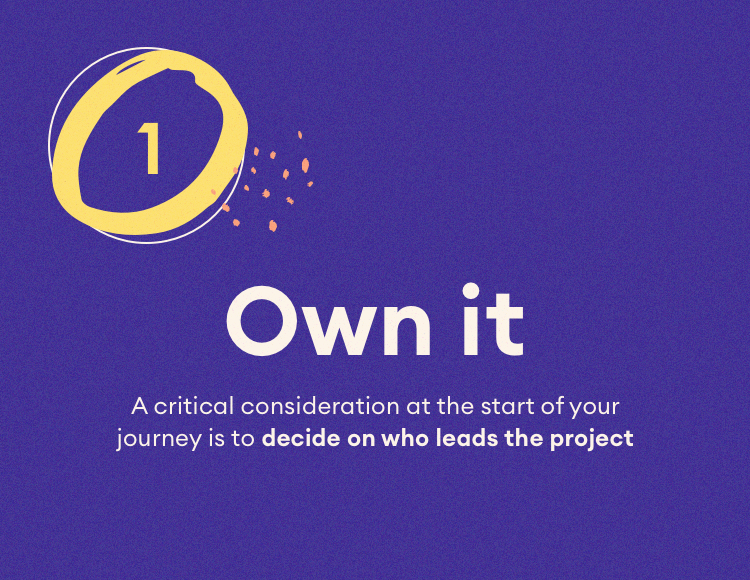
Own it
A critical consideration at the start of your journey is to decide on who leads the project. Is this something owned by a designated project team within the business or is it owned by the CEO and wider C-suite?
“The CEO and C-Suite should collectively own purpose,” says Whitter. “Leadership should be taking a personal responsibility to bring this to life within the organisation - regardless of how big your firm is.”
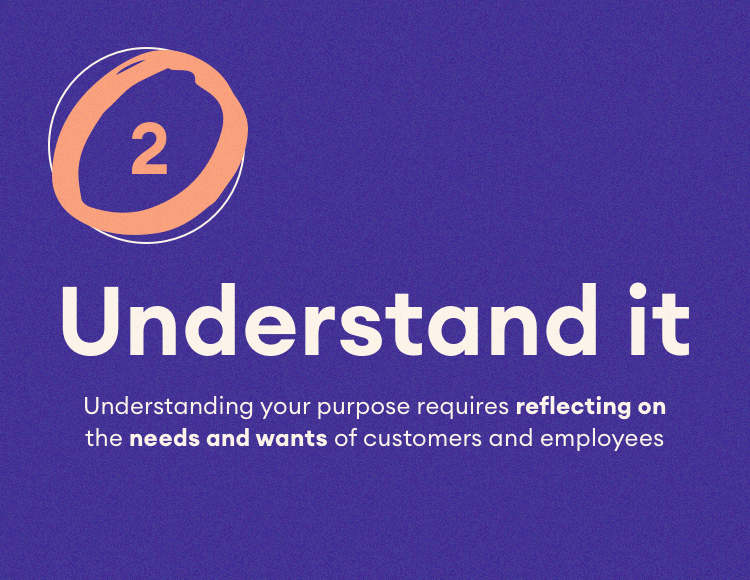
Understand it
Understanding your purpose requires reflecting on the needs and wants of both customers and employees, as well as what you do as a business.
“People and consumers need to know why companies exist and how they act. People aren’t adverse to voting with their feet, so ask yourself: why do we exist? What do we stand for? This is fundamental,” says Manners.
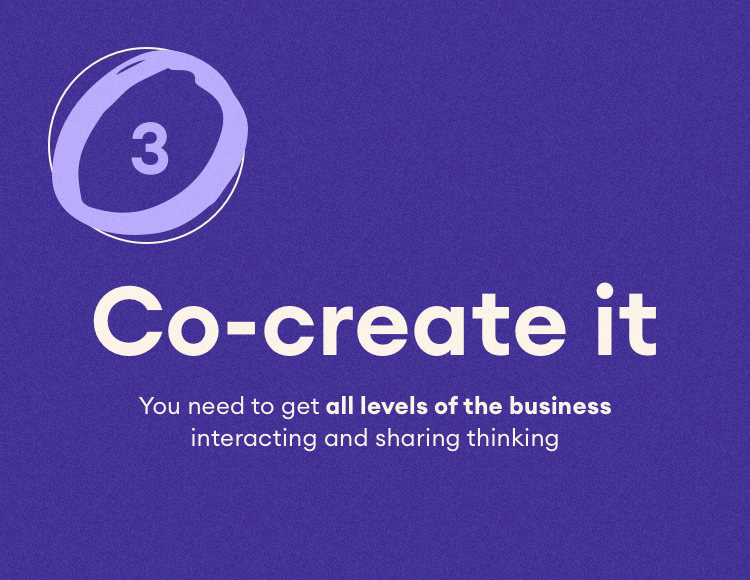
Co-create it
“Co-creation is the key to becoming a purposeful business,” says Whitter. “When you co-create, that’s when you’ll arrive at a purpose that people believe in and can live. That’s when you get real traction.”
Co-creation can take the form of workshops, design sessions, and forums, as well as digital initiatives to capture employee sentiment such as surveys or video testimonials. You need to get all levels of the business interacting and sharing thinking.
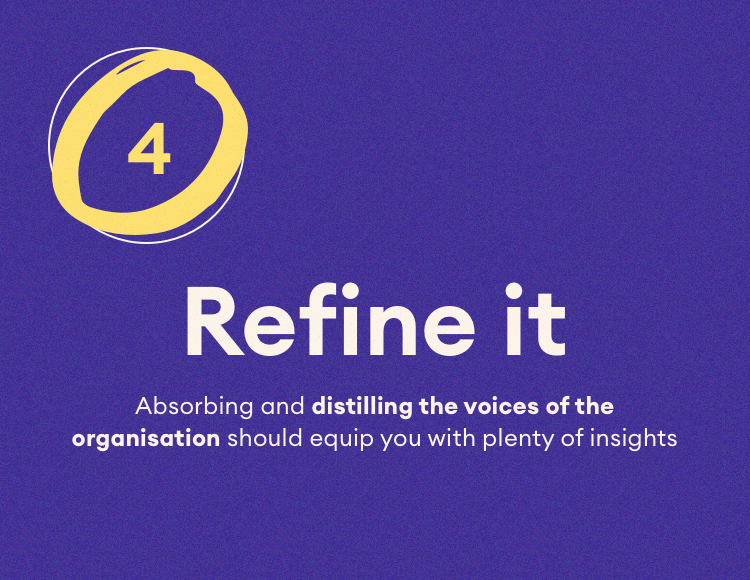
Refine it
Absorbing and distilling the voices of the organisation should equip you with plenty of insights that can be refined and distilled into your final purpose statement. Bear in mind the lessons learned from co-creation and work to reframe the organisation’s purpose, mission, values, and EVP to reflect your purpose.
“When you harness the connection between purpose, mission, and company values as an integrated strength, that’s when you start to see them become the lived truth of an organisation,” says Whitter.

Socialise it
Co-creation ensures that employees are at least familiar with, if not actively bought into the purposeful journey you are on. This is a major plus when it comes to socialising your purpose. Delegate comms to the right teams so that messaging is clear, concise, and consistent. Liaise with HR and wellbeing teams from a people perspective, and ensure those at the top are actively discussing and living your purpose in everything they do.
“Long gone are the days where purpose sits with one part of the business because it impacts all of the business,” says Manners. “Purpose starts at the top, but it’s an organisational-wide piece - you need the right people who believe in it to help you roll it out.”
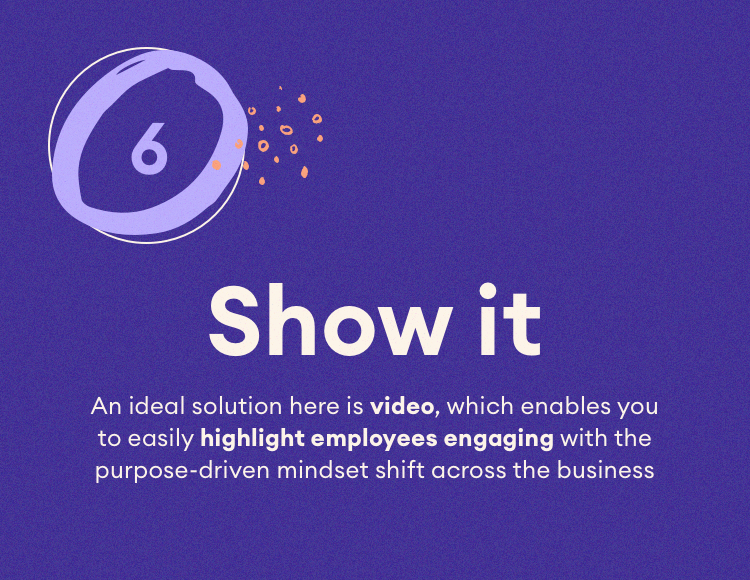
Show it
You’ve talked the talk. Now it’s time to walk the walk and show the world that your organisational purpose is a lived truth in the business. An ideal solution here is video, which enables you to easily highlight employees engaging with the purpose-driven mindset shift across the business.
Video also provides first-hand evidence of how much of a lived truth your purpose has become, while also generating a bank of rich content that can positively impact activity like recruitment. A short, snappy video that can be watched inside a minute or two is a simple and effective way of catalysing positive behaviour internally while also winning over prospective talent and customers externally.
“Purpose needs to be relentlessly socialised through the tools in your arsenal: your teams, your tech, and your people. Being able to watch employees engage with and discuss something that is real, authentic, and a truly lived experience can help to create momentum throughout the business, says Freddy Cleveley at Seenit.
About Seenit
Seenit is the employee-generated video platform for businesses. We help companies like EE, Novartis, and Vodafone securely crowdsource content from their colleagues and edit it into videos that engage 8x more than traditional content. All with a tool that anyone can use in minutes, no video experience needed.
Seenit saves you time, money, and effort and is the flexible, scalable, and safe way to crowdsource and edit content from your colleagues, wherever they are. Seenit produced content is up to 20x faster to collect, reduces production spend by 70%, and increases video output 9x.
Empower your colleagues to create engaging and authentic videos to attract talent, enhance your employer brand, and engage your colleagues with Seenit, the employee-generated video platform.

